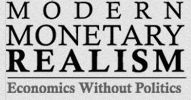By Cullen Roche
It is useful to think of the global economy as one dynamic and complex machine. And in recent years, many have noted that the old clunker is stalling, even suggesting that it is in need of a total overhaul. The benefit of a breakdown is that it gives us all time to reflect.
It can even prompt us to roll up our sleeves, get our hands dirty and work out how to improve the machine. In the case of the economy, this inspection has led to a healthy questioning of mainstream economics and the insurgence of heterodox schools of economic thought.
I believe few schools have been more helpful in recent years than so-called Modern Monetary Theory and its offshoot, Modern Monetary Realism. Like any economic theory, there is only so much detail one can fit into in an op-ed (and only so much a reader wants). But there are some simple and important lessons to draw from these ways of looking at the world, which help to explain the course of the financial crisis. First, it matters if you are an autonomous currency issuer.
The eurozone crisis has exposed the fundamental flaw in the European Monetary Union. Many people see the crisis as a debt crisis, but I see the debt crisis as a result of a currency crisis.
Eurozone countries are akin to US states. They are users of a national currency, not issuers. Unlike the US, there is no central treasury to oversee the allocation of funds in case of funding shortages. Because all countries use the same currency, there can be no trade rebalancing via floating exchange rates.
The great bond vigilante myth has been exposed. The idea that bond investors will revolt against any nation with high sovereign debt has been shown to be incorrect. And a funny thing has happened as the US, the UK and Japan have continued to accumulate higher levels of government debt – their bond yields have remained low. The reason for this lies in the importance of being a currency issuer rather than a currency user. A currency user can always “run out of money” whereas a currency issuer always has access to a printing press. So being an autonomous currency issuer has proved to be a beneficial monetary structure throughout the crisis.
Second, our belief in the so-called “money multiplier” has exposed deep flaws in our understanding of modern banking.
When the US Federal Reserve introduced the first and second rounds of quantitative easing, one of the more common predictions was hyperinflation. The thinking was rather simple. With the Fed supplying the banking system with excess reserves, the banks would then be able to create money freely, according to the money multiplier theory taught in every economics class. But a funny thing has happened. Despite a trillion-dollar expansion in reserves, bank lending has continued to decline.
Heterodox schools of thought, such as MMT, predicted this trend. They stated that banks are never actually reserve constrained. This proved to be true in the wake of the crisis as more reserves failed to boost lending or cause catastrophic inflation. This misunderstanding of banking led policy makers to enact misguided programmes that have distracted from the real problems at hand.
Third, government budget deficits are not always the enemy.
While the global economy entered a near death spiral in 2008 and the private banking system froze, there proved to be only one entity that could pull us out of the tailspin – the government. This was counter to the intuition of many traditionally rightwing economists who view government as a perpetual problem.
I prefer to think of the government as being in partnership with the people. With the proper checks and balances, the government should serve a public purpose and not detract from our potential prosperity. Government can certainly be an impediment to the flourishing of the marketplace. But it is important that we better understand the relationship between government and our monetary system so we can come to a smarter view of what the government’s role should be in our economy. As banks and households have both reduced their debt level, government spending has proved to be essential. Austerity has failed miserably in many European countries and further reductions in government spending risk turning a eurozone recession into a depression, hurting millions of people.
These are just a few of the lessons that heterodox schools have been promoting for many years. My hope is that the crisis will continue to force us all to explore the machine and try to discover what went so very wrong with it. Only then will we be able to help steer it in a manner that avoids future crisis. Unfortunately, the misconceptions and myths run deep, and the engineers who built this machine continue to guide us right into oncoming traffic.
The writer is founder and editor-in-chief of the Pragmatic Capitalism blog Copyright The Financial Times Limited 2012.
See online: A new way of thinking about the global machine

